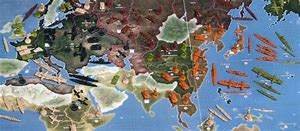Axis and Allies - a game underway
I finally got the chance to sit down and sort out all the sets of Axis and Allies I own - together with a rather large selection recently acquired from Tim Gow of Megablitz and More fame. Tim had acquired a box full of Axis and Allies miniatures that were mixed and having no longer any need for the same offered them to your truly. An exchange was duly agreed and so the collection needing sorting consisted of the following:
1 x 2004 edition
2 x 1941 edition
1 x 1942 original version
1 x 1942 second edition
From Tim as near as I can tell the collection consisted of three sets. I think they are the following:
1 x Original Milton Bradley 1980s version (very generic models)
1 x D Day edition (contains some very useful bunkers and some P47 Thunderbolts)
1 x 1942 original version
Given that theses sets average around 370 pieces each (except for the two 1941 edition at 160 each) you can see the scale of the task.
I sorted all the pieces into national types and each nation was assigned a storage box, similar to those that the block armies reside in. I also made sure that national equipment stayed with its home nation. For example all of the Sumner and Fletcher class destroyers are stored with the US collection and the British have all the copies of HMS Hood.
There are numerous examples of types that I have more of than can reasonably used - HMS Hood being an example as I have 12 of them. The British also have rather a lot of Spitfires and four engine bombers - the Halifax mainly but also a dozen Lancaster bombers. The US P40 is a useful addition and will serve with the Russians and the RAF. The surfeit of single engine fighters is good because it means theatre specific paint jobs will be the order of the day. The main German tank is the Panther which is shame but again, there are sufficient to able to have fun with camouflage schemes. The good old Sherman will of course be used with the British and the Russians although they have plenty of 76mm armed T34 tanks. The Japanese tank looks like a dead ringer for a Panzer 38(t) so I suspect these may feature at some point.
I also have a huge amount of 20mm infantry for each of the combatant nations. These figures are typical of the national type so you have a jackbooted German, a Russian with a SMG and British infantryman in 8th Army shorts. The Japanese entry is looks suitably menacing with a fixed bayonet whilst the GI looks very 'Commando comic' with his rifle across his chest and advancing purposefully.
These could be readily used for a game and indeed, it would not be too much hassle to paint them. I intend doing this at some point but that is a project in itself as I would need to add support and vehicles etc to make full use of them. It is on the cards but I have no idea when as the first order of business remains the naval dimension.
For the present I have pretty much all that I need so the order to Historical Boardgames is a lot easier to organise. For the most part it is ships but I will also be adding in some land transport, trucks and similar. Other than that it is about as far as I need to go.
Many thanks once again to Tim Gow for thinking of me.









